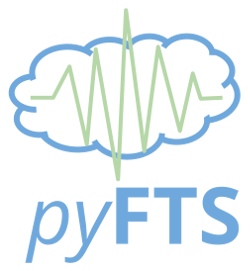pyFTS.models.multivariate package¶
Module contents¶
Multivariate Fuzzy Time Series methods
Submodules¶
pyFTS.models.multivariate.FLR module¶
pyFTS.models.multivariate.common module¶
-
class
pyFTS.models.multivariate.common.MultivariateFuzzySet(**kwargs)[source]¶ Bases:
pyFTS.common.Composite.FuzzySetMultivariate Composite Fuzzy Set
-
append_set(variable, set)[source]¶ Appends a new fuzzy set from a new variable
Parameters: - variable – an multivariate.variable instance
- set – an common.FuzzySet instance
-
pyFTS.models.multivariate.variable module¶
pyFTS.models.multivariate.flrg module¶
-
class
pyFTS.models.multivariate.flrg.FLRG(**kwargs)[source]¶ Bases:
pyFTS.common.flrg.FLRGMultivariate Fuzzy Logical Rule Group
-
get_lower(sets)[source]¶ Returns the lower bound value for the RHS fuzzy sets
Parameters: sets – fuzzy sets Returns: lower bound value
-
get_membership(data, variables)[source]¶ Returns the membership value of the FLRG for the input data
Parameters: - data – input data
- sets – fuzzy sets
Returns: the membership value
-
pyFTS.models.multivariate.partitioner module¶
-
class
pyFTS.models.multivariate.partitioner.MultivariatePartitioner(**kwargs)[source]¶ Bases:
pyFTS.partitioners.partitioner.PartitionerBase class for partitioners which use the MultivariateFuzzySet
-
build(data)[source]¶ Perform the partitioning of the Universe of Discourse
Parameters: data – training data Returns:
-
fuzzyfy(data, **kwargs)[source]¶ Fuzzyfy the input data according to this partitioner fuzzy sets.
Parameters: - data – input value to be fuzzyfied
- alpha_cut – the minimal membership value to be considered on fuzzyfication (only for mode=’sets’)
- method – the fuzzyfication method (fuzzy: all fuzzy memberships, maximum: only the maximum membership)
- mode – the fuzzyfication mode (sets: return the fuzzy sets names, vector: return a vector with the membership
values for all fuzzy sets, both: return a list with tuples (fuzzy set, membership value) )
:returns a list with the fuzzyfied values, depending on the mode
-
search(data, **kwargs)[source]¶ Perform a search for the nearest fuzzy sets of the point ‘data’. This function were designed to work with several overlapped fuzzy sets.
Parameters: - data – the value to search for the nearest fuzzy sets
- type – the return type: ‘index’ for the fuzzy set indexes or ‘name’ for fuzzy set names.
Returns: a list with the nearest fuzzy sets
-
pyFTS.models.multivariate.grid module¶
-
class
pyFTS.models.multivariate.grid.GridCluster(**kwargs)[source]¶ Bases:
pyFTS.models.multivariate.partitioner.MultivariatePartitionerA cartesian product of all fuzzy sets of all variables
-
class
pyFTS.models.multivariate.grid.IncrementalGridCluster(**kwargs)[source]¶ Bases:
pyFTS.models.multivariate.partitioner.MultivariatePartitionerCreate combinations of fuzzy sets of the variables on demand, incrementally increasing the multivariate fuzzy set base.
-
fuzzyfy(data, **kwargs)[source]¶ Fuzzyfy the input data according to this partitioner fuzzy sets.
Parameters: - data – input value to be fuzzyfied
- alpha_cut – the minimal membership value to be considered on fuzzyfication (only for mode=’sets’)
- method – the fuzzyfication method (fuzzy: all fuzzy memberships, maximum: only the maximum membership)
- mode – the fuzzyfication mode (sets: return the fuzzy sets names, vector: return a vector with the membership
values for all fuzzy sets, both: return a list with tuples (fuzzy set, membership value) )
:returns a list with the fuzzyfied values, depending on the mode
-
